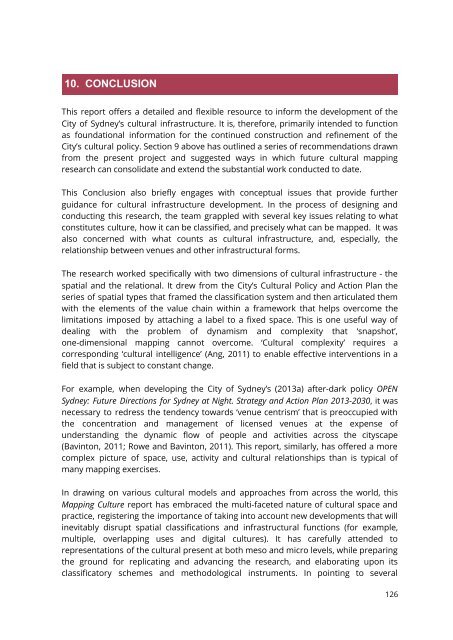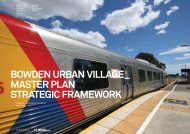MAPPING CULTURE
Mapping-Culture-Venues-and-Infrastructure-in-the-City-of-Sydney
Mapping-Culture-Venues-and-Infrastructure-in-the-City-of-Sydney
You also want an ePaper? Increase the reach of your titles
YUMPU automatically turns print PDFs into web optimized ePapers that Google loves.
10. CONCLUSION<br />
This report offers a detailed and flexible resource to inform the development of the<br />
City of Sydney’s cultural infrastructure. It is, therefore, primarily intended to function<br />
as foundational information for the continued construction and refinement of the<br />
City’s cultural policy. Section 9 above has outlined a series of recommendations drawn<br />
from the present project and suggested ways in which future cultural mapping<br />
research can consolidate and extend the substantial work conducted to date.<br />
This Conclusion also briefly engages with conceptual issues that provide further<br />
guidance for cultural infrastructure development. In the process of designing and<br />
conducting this research, the team grappled with several key issues relating to what<br />
constitutes culture, how it can be classified, and precisely what can be mapped. It was<br />
also concerned with what counts as cultural infrastructure, and, especially, the<br />
relationship between venues and other infrastructural forms.<br />
The research worked specifically with two dimensions of cultural infrastructure - the<br />
spatial and the relational. It drew from the City’s Cultural Policy and Action Plan the<br />
series of spatial types that framed the classification system and then articulated them<br />
with the elements of the value chain within a framework that helps overcome the<br />
limitations imposed by attaching a label to a fixed space. This is one useful way of<br />
dealing with the problem of dynamism and complexity that ‘snapshot’,<br />
one-dimensional mapping cannot overcome. ‘Cultural complexity’ requires a<br />
corresponding ‘cultural intelligence’ (Ang, 2011) to enable effective interventions in a<br />
field that is subject to constant change.<br />
For example, when developing the City of Sydney’s (2013a) after-dark policy OPEN<br />
Sydney: Future Directions for Sydney at Night. Strategy and Action Plan 2013-2030 , it was<br />
necessary to redress the tendency towards ‘venue centrism’ that is preoccupied with<br />
the concentration and management of licensed venues at the expense of<br />
understanding the dynamic flow of people and activities across the cityscape<br />
(Bavinton, 2011; Rowe and Bavinton, 2011). This report, similarly, has offered a more<br />
complex picture of space, use, activity and cultural relationships than is typical of<br />
many mapping exercises.<br />
In drawing on various cultural models and approaches from across the world, this<br />
Mapping Culture report has embraced the multi-faceted nature of cultural space and<br />
practice, registering the importance of taking into account new developments that will<br />
inevitably disrupt spatial classifications and infrastructural functions (for example,<br />
multiple, overlapping uses and digital cultures). It has carefully attended to<br />
representations of the cultural present at both meso and micro levels, while preparing<br />
the ground for replicating and advancing the research, and elaborating upon its<br />
classificatory schemes and methodological instruments. In pointing to several<br />
126



